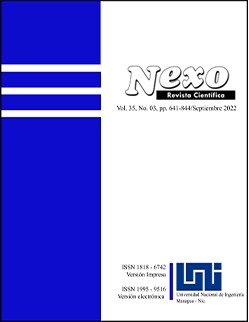Thermo-hydraulic rating of a shell and tube heat exchanger for methanol condensation
DOI:
https://doi.org/10.5377/nexo.v35i03.15001Keywords:
Methanol, Percent excess area, Pressure drop, Rating, Shell and tube heat exchangerAbstract
Shell and tube heat exchangers are the most common type of heat exchangers, and are applicable for a wide range of operating temperatures and pressures. In the present work the thermo-hydraulic rating of a shell and tube heat exchanger was carried out, in order to perform the condensation of a methanol stream using water as coolant. The overall heat transfer coefficient for both the sensible-heat and latent-heat zone had values of 166.41 W/m2.K and 1,198.39 W/m2.K, respectively; while the required total heat transfer area and percent excess area had values of 38.08 m2 and 3.05 %, respectively. The pressure drops of methanol and water streams reached the values of 51,490.84 Pa and 2,890.50 Pa, respectively. The proposed shell and tube heat exchanger can be employed satisfactorily for the demanded heat transfer service, since the calculated percent excess area does not exceed 25%, and the pressure drop of the water stream does not exceed the value of 80,000 Pa.
Downloads
1863
Downloads
Published
How to Cite
Issue
Section
License
Copyright (c) 2022 Universidad Nacional de Ingeniería

This work is licensed under a Creative Commons Attribution 4.0 International License.
The authors who publish in Nexo Scientific Journal agree to the following terms:
- Authors retain the copyright and grant the journal the right of the first publication under the license Creative Commons Attribution License, which allows others to share the work with a recognition of the authorship of the work and the initial publication in Nexo Scientific Journal.
- Authors may separately establish additional agreements for the non-exclusive distribution of the version of the work published in the journal (for example, in an institutional repository or a book), with the recognition of the initial publication in Nexo Scientific Journal.
- Authors are allowed and encouraged to disseminate their works electronically (for example, in institutional repositories or in their own website) before and during the submission process, as it can lead to productive exchanges, as well as earlier and greater citation of published works.










